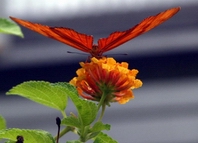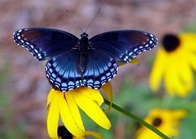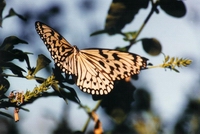|
 LISTEN-TEXT: LISTEN-TEXT:
 Hi friends, today I would like to introduce a new Chinese classical poem. This poem, written by the former Chinese leader Mr. Mao Ze Dong (1896 to 1976), is called Die2 Lian4 Hua1-Da2 Li3 Shu2 Yi1, which means The Butterfly Loves the Flower-Reply to Mrs Li Shuyi. He wrote it to express how he loved and missed his wife, Ms. Yang Kahui (1901 to 1930) who was killed by their enemies in 1930. Hi friends, today I would like to introduce a new Chinese classical poem. This poem, written by the former Chinese leader Mr. Mao Ze Dong (1896 to 1976), is called Die2 Lian4 Hua1-Da2 Li3 Shu2 Yi1, which means The Butterfly Loves the Flower-Reply to Mrs Li Shuyi. He wrote it to express how he loved and missed his wife, Ms. Yang Kahui (1901 to 1930) who was killed by their enemies in 1930.
In 1957, one of the best friends of Yang Kaihui's -- Ms. Li Shuyi wrote a poem to remember her husband Liu Zhi Xun, who was Mr. Mao's comrade in arms, and who was also killed by their enemies in 1932. So, Mr. Mao Zedong wrote this poem to reply to her and hers. This poem was published on New Year's Day in 1958.
THE MAIN MEANING OF THE POEM LISTEN-TEXT LISTEN-TEXT
Butterfly Loves Flower?reply Ms. Li Shuyi
I lost my lovely wife Yang,
You lost your dear husband Liu.
Their souls flew up to the highest place in the heaven,
They asked Wu Gang what does he have in the Moon Palace?
Wu Gang brought out a drink of flowers of cherry bay.
Lonesome Chang E extended her wide and big sleeves,
She danced for their loyal souls in the 10 thousands mile vast sky.
Suddenly, it was reported that the tigers in the human world had all been caught;
Their happy tears poured down like a cloudburst.
 CHINESE PRONUNCIATION: CHINESE PRONUNCIATION:
Die2 Lian4 Hua1 ? Da2 Li3 Shu2 Yi1
Wo3 shi1 jiao1 yang2 jun1 shi1 liu3,
Yang2 liu3 qing1 yang2 zhi2 shang4 chong2 xiao1 jiu3.
Wen4 xun4 wu2 gang2 he2 suo3 you3,
Wu2 gang1 peng3 chu1 gui4 hua1 jiu3.
Ji4 mo4 Chang2 e2 shu1 guang3 xiu4,
Wan4 li3 chang2 kong1 jie3 wei4 zhong1 hun2 wu3.
Hu1 bao4 ren2 jian1 ceng2 fu2 hu3,
Lei4 fei1 dun4 zuo4 qing1 pen2 yu3.
NEW WORDS:
die2: butterfly (die2 or hudie2 means butterfly)
lian4:feel attached to, love
hua1: flower
da2: reply, answer
wo3: I, me
shi1: lose
jiao1 Yang2:lovely Yang. Means my lovely wife. Yang is the family name of Yang Kai Hui, here points the wife of Chairman Mao's.
jun1: you (This is an ancient and literary Chinese word)
Liu: the family name of Liu Zhixun, the husband of Ms. Li Shuyi.
qing1 yang2: flow, fly
zhi2:straight
shang4: up
chong2:layer
xiao1:heaven, sky
jiu3:nine
chong2 xiao1 jiu3: the highest place/layer of the sky/heaven.
NOTE:In Chinese ancient fable, people thought that the sky has 9 layers, the 9th layer is the highest one.
wen4 xun4:ask
Wu Gang: A character from Chinese ancient fable, he a celestial being named Wu Gang in the Moon Palace, he had made some mistake. So, he was punished by having to cut down a magical cherry bay tree that was 1650 meters tall. Every time he swung his axe into the trunk of the magical tree, the resulting cut immediately healed and so Wu Gang was doomed never to finish his task.
he2what
suo3 you3: have, there is
he2 suo3 you3: what have
peng3 chu1:hold up with both hands, take out
gui4 hua2:the flowers of cherry bay
jiu3: wine, drink
ji4 mo4:lonesome
Chang2 E2:A character from Chinese ancient fable. She stole and swallowed her husband’s pill of eternal life, and as a result flew up to the Moon Palace.
 shu1:extend shu1:extend
guang3 xiu4: wide and big sleeve.
guang3: wide and big
xiu4: sleeve
wan4 li3:ten thousand miles
chang2 kong1:vast sky/heaven
chang2:long, vast
kong:sky, heaven
qie3:just
wei4: for
zhong1 hun2: loyal soul
zhong1:loyal
hun2:soul
wu3:dance
hu1:suddenly
bao4:report
ren2 jian1: human being's world, the world
ceng2:already, ever
fu2 hu3:overcome the tiger, here means that the enomy has been conquered.
lei4:tear
fei1: fly
dun4 zuo4:suddenly changed/become something
qing1 pen2 yu3:cloudburst,downpour,drencher
yu3:rain
蝶恋花?答李淑一 LISTEN-TEXT LISTEN-TEXT
我失骄杨君失柳,
杨柳轻矧直上重霄九。
问讯吴刚何所有,
吴刚捧出桂花酒。
寂寞嫦娥舒广袖,
万里长空且为忠魂舞。
忽报人间曾伏虎,
泪飞顿作倾盆雨。
Die2 Lian4 Hua1 ? The Butterfly Loves the Flower is a Ci2 Ge2, which is one of the forms of Chinese classical poetry. Ci1 is a form of classical poetry and conforms to a definite pattern. It was first used in the Tang Dynasty (617 to 907) but was at its most popular in the Song Dynasty (960 to 1279). It was developed based on Tang poetry and could be sung to music. Ci2 Ge2 also has a pattern and is governed by certain rules that determine such features as the number of words in each line, the cadences of different parts and what the foot is at the end of a line… People can fill the pattern with their own content provided the do so according to the rules. So in China, people say “write a poem and fill in the lyrics”. There are over 1000 patterns of Ci2 Ge2 in the Chinese classical field. In modern China, very few young people use this form, but there are still many elder people, researchers, and students who major in Chinese classical language and literature, who use it very well.

Mr. Mao Zedong was just a great poet who used the ancient poetry patterns to write. He has left 37 famous classical poems to the world. If you are interested, I will to do my best to introduce some of them to you later.
If you have any questions, comments, advices or suggestions, please write to shirley@ebridge.cn. You are welcomed.
--Shirley
Write on Aug 23,2004
Edited and Recorded on Sat., Aug 26, 2005
Mike Corrected It On Mon., Sep 12,2005
|

